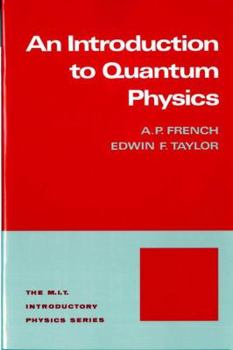Introduction to Quantum Physics
Select Format
Select Condition 
Book Overview
Almost everything we touch and see (together with nerve impulses and light, the messengers of touch and sight) owes its character to the subtle architecture of atoms and molecules, an architecture whose building code is quantum mechanics. And when we come to large-scale phenomena that depends in a direct way on the details of atomic processes-for example lasers, superconductors, and solid-state electronics-then the explicit use of quantum physics is essential.
Format:Paperback
Language:English
ISBN:0393091066
ISBN13:9780393091069
Release Date:May 1978
Publisher:W. W. Norton & Company
Length:696 Pages
Weight:2.03 lbs.
Dimensions:1.3" x 6.9" x 8.6"
Customer Reviews
5 ratings
Great treatment of basic topics
Published by Thriftbooks.com User , 22 years ago
Several of the other reviews here express my general, very positive feelings about this book, so I'll concentrate on two specific examples which illustrate the teaching emphasis of the book's authors. Chapters 6 and 7 introduce quantum states with a brilliant discussion of Dirac's bracket notation using polarization of light as the driving example. The student at this level typically already knows what to expect when, for example, linearly polarized light passes through a linear analyzer oriented at an angle with respect to the polarization axis. The authors develop a set of projection amplitudes for linear and circular polarization which reproduce the results familiar to the student. This makes state vectors easy to understand and, in turn, it's much easier to learn and accept the less intuitive results which come from solving more complex problems later on. I would recommend this book for these two chapters alone.In Chapter 9 the authors in just a few pages develop a simple but quantitative theory of alpha decay which is easy to follow and relates half-life (or decay constant) to alpha-particle energy with no adjustable parameters. They then compare their result to experiment and show agreement over 24 orders of magnitude of half-life. This example wonderfully illustrates the power of simple, clear reasoning to achieve a widely applicable result. Fantastic job!I own three or four introductory quantum mechanics texts, but this is the one I turn to first.
Easy to read and really focuses on the Physics
Published by Thriftbooks.com User , 23 years ago
OK, so this book is old, having been written in the 1970s. For all that, it still does the core things excellently: namely focus on the Physics, the experiments, the theory, AND the people behind the advances.After going through the antecedents of the classical atomic model, the authors quickly move onto the wave-particle duality. They describe, throughout, groundbreaking experimental work of the likes of Thompson and Davisson & Germer. After setting the foundations, French and Taylor go to the discussion of the one dimensional Schrodinger equation, its physical meaning, and several examples of solutions by means of qualitative plots.Photons and Quantum States, Angular momentum, Atomic Systems, a detailed discussion of the Hydrogen atom and Radiation from atoms make up the rest of the book.What I particularly like about this book is that it is grounded in the Physics, with experiment and theory given an equal footing. The authors are gentle with their use of mathematics. The concept of operators is applied to the physical problem. This, despite what to some people would be the book's "old fashioned" nature, is refreshing. Too often, the authors of modern books on Quantum Physics "pose" with fancy mathematics to try to impress their colleagues or students.This book is easy to read, there are plenty of worked examples and end of chapter exercises to keep the student busy. I recommend this book thoroughly.
Insightful intro text for the able freshmen/sophomores
Published by Thriftbooks.com User , 24 years ago
This book was ahead of its time when it was published in 1978 and is still one of the better intro texts that stresses the basic principles and the experimental justifications. AP French is well-known for a whole series of rigorous intro physics texts he wrote for MIT students in the 1970s. The explanations and theoretical foundation in this book are very carefully laid out for the reader. Combined with insightful end-of-chapter problems, this is the preferred text for the able honors freshman/sophomore before he/she moves on to Griffiths's quantum mechanics book. When I was in college many years ago using Tipler's Modern Physics text for an intro to quantum mechanics and special relativity, it was the French/Taylor book that gave me the solid foundation I needed for the quantum mechanics part. Although co-author EF Taylor said on his personal website that this book is dated, I still find it - after all these years - a great starting point for the serious beginning physics undergraduate.
Best introductory book on the subject.
Published by Thriftbooks.com User , 26 years ago
This is one of the clearest and well thought out introductions on quantum physics that I've seen. It is beautifully written with abundant diagrams and examples. The chapter on photons and polarization is an excellent pedagogical approach to understanding state vectors. This will also come in handy later on in a more advanced course when trying to understand the motivations behind the postulates of quantum mechanics.
Excellent organization and clear explanations
Published by Thriftbooks.com User , 26 years ago
This book is very pedagogical. It follows a logical order in presenting the very complicated development of quantum physics. It's like taking a step back and collecting your thoughts. No physics student or physics teacher should be without it.





